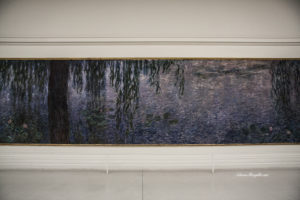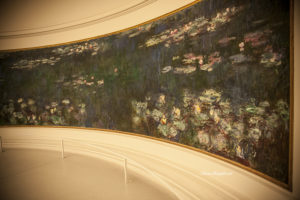Claude Monet’s water lilies: Orangerie in Paris
Italian version below*
In October 1920 Monet plans to offer to the French State twelve paintings which were initially intended for the decoration of a pavilion to be built in the future Rodin Museum.
The pavilion will never be completed and the work will be destined from 1927 to the Orangerie inside “Les Tuileries”, an enchanting garden on which the Louvre overlooks.
The chosen subject – water lilies – is actually a topic Monet has worked on and has been fond of for some time. A love and hate that will accompany him until the last days of life.
The cycle of “Water Lilies”, the supreme work of the Parisian artist, was defined by André Masson in 1952 as the Sistine Chapel of Impressionism. It is a unique masterpiece of which there are no equals in the world, fundamental for the study of Monet’s last working season.
The artist approaches the work when he was now blind from cataract problems. He concentrates on the surface of the water and studies it for years, reflections, lights, shadows, emotions.
A subject analyzed in the different hours of the day and seasons that turns out to be a cosmic landscape in which to immerse yourself! Monet feels subjected to continuous transformations because everything grows and revives. In short, through transformations, I follow nature without being able to grasp it.
The result? A gigantic “dream” painting in which each of us, as Monet said, can see what he wants.
The canvases, of about 4 meters each, decorate two elliptical rooms of the Orangerie. They hang side by side to form a unique surface that involves the visitor at 360 degrees.
Do you want to know more about Monet and his garden residence in Giverny?
Click HERE
All rights reserved*
Nell’Ottobre del 1920 Monet pensa di offrire allo Stato francese dodici tele che, inizialmente, erano destinate alla decorazione di un padiglione da costruirsi nel futuro Museo Rodin.
Il padiglione non verrà mai portato a termine e l’opera sarà destinata dal 1927 all’ Orangerie des Tuileries, incantevole giardino su cui prospetta il Louvre.
Il soggetto scelto – le ninfee- sono in realtà una tematica a cui Monet lavora ed è affezionato da tempo. Un amore e odio che lo accompagnerà fino agli ultimi giorni di vita.
Il ciclo delle “Ninfee” (Water Lilies), lavoro supremo dell’artista parigino, fu definito da André Masson nel 1952 come la Cappella Sistina dell’Impressionismo. E’ un capolavoro unico di cui non esistono eguali al mondo, fondamentale per lo studio dell’ultima stagione lavorativa di Monet.
L’artista si approccia all’opera quando è oramai cieco per problemi di cataratta. Si concentra sulla superficie dell’acqua e ne studia per anni, riflessi, luci, ombre, emozioni.
Un soggetto analizzato nelle diverse ore del giorno e delle stagioni che si rivela essere un paesaggio cosmico in cui potersi immergere! Monet si sente sottomesso alle continue trasformazioni, perché tutto cresce e rinverdisce. Insomma, a forza di trasformazioni, io seguo la natura senza poterla afferrare.
Il risultato? Un gigantesco quadro “da sogno” in cui ognuno di noi, come affermò Monet, può vedere ciò che vuole.
Le tele, di circa 4 metri ciascuna, decorano due ambienti ellittici dell’ Orangerie. Sono appese una accanto all’altra a formare una superficie unica che coinvolge il visitatore a 360 gradi.
Vuoi saperne di più su Monet e la sua residenza giardino a Giverny?
Clicca QUI
InfoSite: Orangerie
Sostieni la #culturachevince, aiuta la condivisione.

